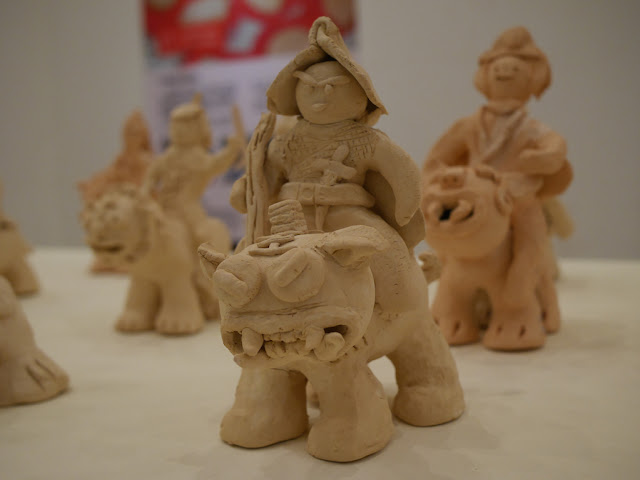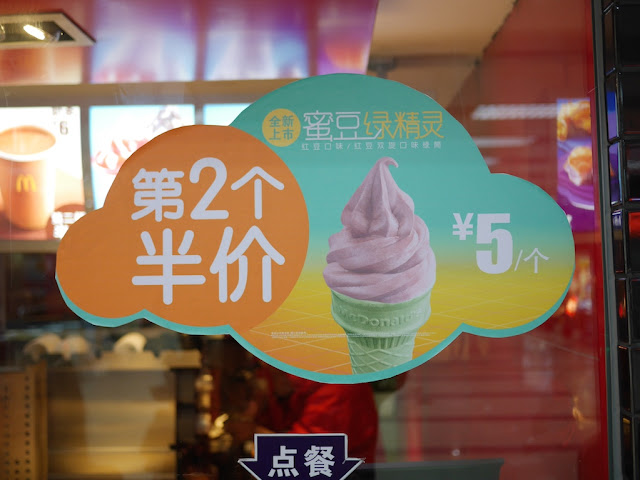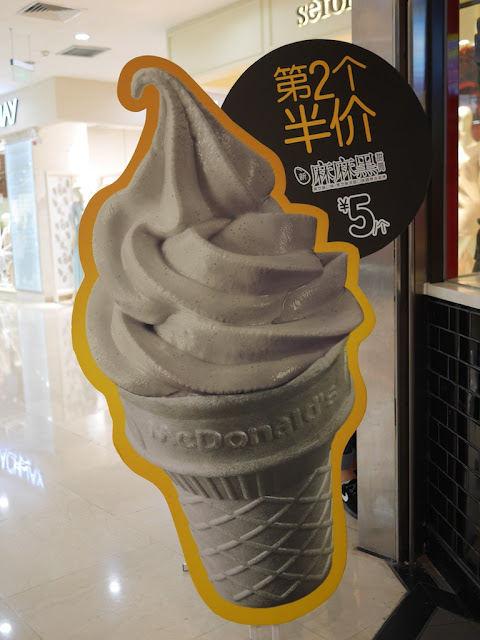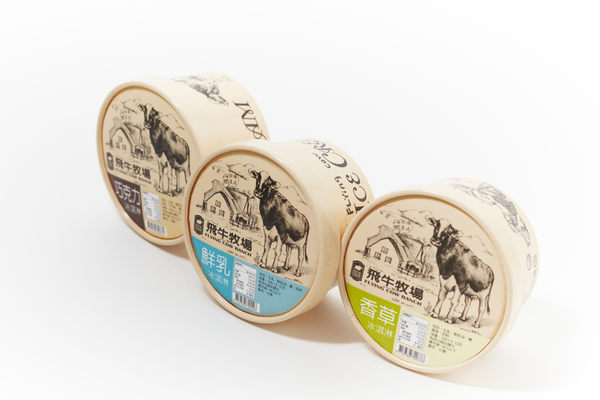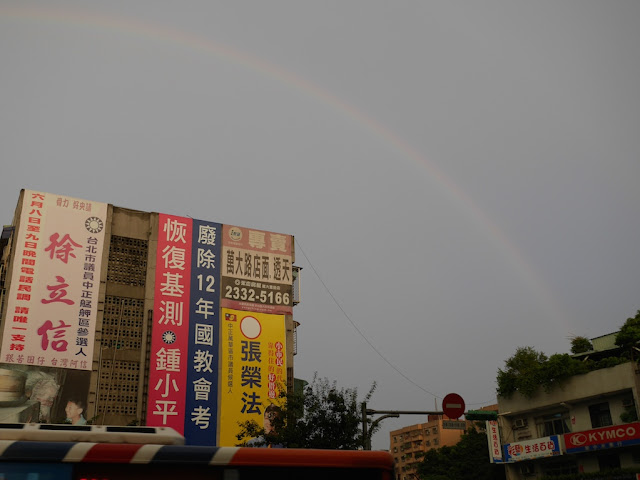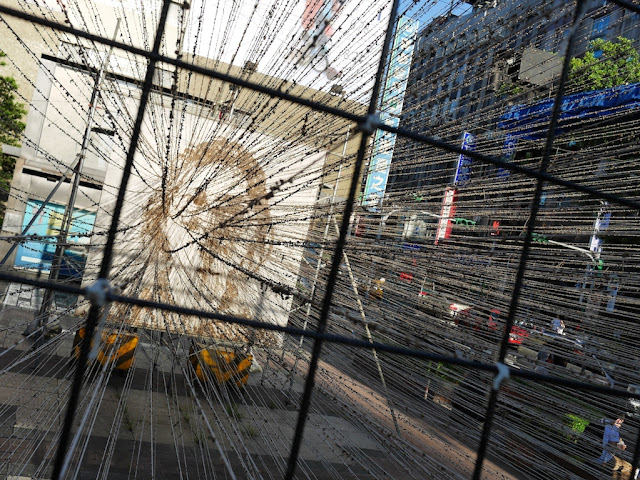Showing posts with label Taiwan. Show all posts
Showing posts with label Taiwan. Show all posts
Tuesday, April 12, 2016
Sunday, April 10, 2016
Saturday, April 9, 2016
Thursday, April 7, 2016
Two Mythical Qilins on Display in Kinmen
Posted by
Brian Glucroft
at
12:07 AM
I have been unexpectedly occupied since praising Yeh's Fermented Eggs. So for today, I will keep it simple and share four photos of artistic creations on display at the Historical Folk Museum in Kinmen.
The qilin (麒麟) sculptures made during the time of the Xuande Emperor, who ruled from 1425 to 1435, were two of my favorites at the museum.
Another set of sculptures at the museum, these made recently by children, provided an unexpected variation on the imaginary creature theme.
Perhaps in 600 years they too will be displayed as examples of ancient art.
The qilin (麒麟) sculptures made during the time of the Xuande Emperor, who ruled from 1425 to 1435, were two of my favorites at the museum.
 |
| Sculpture of a qilin ridden by a "golden boy": 七寶銅麒麟 - 金童 |
 |
| Sculpture of a qilin ridden by a fairy: 七寶銅麒麟 - 仙女 |
Another set of sculptures at the museum, these made recently by children, provided an unexpected variation on the imaginary creature theme.
Perhaps in 600 years they too will be displayed as examples of ancient art.
Monday, April 4, 2016
Glorious Fermented Eggs in Kinmen, Taiwan
Posted by
Brian Glucroft
at
9:52 PM
 |
| When a sign for fermented eggs beckons |
Recently near the historic Wentai Pagoda in Kinmen, I noticed a sign for "Yeh's Fermented Eggs" (葉氏酒釀蛋) and a group of tourists in a short line. I can't say I was craving fermented eggs at the time, but I figured it was worth trying one for posterity. I didn't expect much.
 |
| Beautiful fermented eggs |
Now I will write something I had not expected to write. Yeh's Fermented Eggs are tasty. Really tasty. They might not be enough on their own to justify a trip to the Taiwanese island near Xiamen. But if life brings you to the Wentai Pagoda, I heartily recommend giving an egg a try. The Yehs will appreciate it and so will your fermentation-craving tastebuds, if you have those.
Based on some online photos, it appears Yeh's Fermented Eggs have been sold at no less than two different locations near the pagoda. So my best advice to find it is to ask somebody or follow people who have a twinkle in their eye due to knowing some fermented eggs are about to make their day a bit more special.
 |
| When you wonder if you should buy a few more eggs for the road |
Eggs aren't the way I had expected to first mention that I am currently in Taiwan, but it will do. More about the journey I made from Jieyang and other non-egg topics are on the way.
Saturday, January 16, 2016
Ten Assorted Taiwan 2016 Election Tweets
Posted by
Brian Glucroft
at
10:47 PM
I will keep things simple on an historic night in Taiwan and just share some recent tweets (photos in tweets may not appear if viewed through an RSS reader):
Ah, Renegade Province “Election” Day! Time to get up, do some stretches, check the missile codes, make tea...
— The Relevant Organs (@relevantorgans) January 16, 2016
Apple Daily TW: "Tsai Ing-wen: the first female president in the Chinese-speaking world" #TaiwanElection #Taiwan2016 pic.twitter.com/O1KQ6b5EPP
— Kristie Lu Stout CNN (@klustout) January 16, 2016
Breaking: Sina Weibo (western media call it China's Twitter) censors just blocked Taiwan's first female president. pic.twitter.com/2wfggtVQ9Y
— Eddie Du (@Edourdoo) January 16, 2016
It ain't Taiwan without a night market. Even at Tsai's prez announcement. #TaiwanElection pic.twitter.com/vpFZUhW1wH
— Ellis Liang (@EllisLiang) January 16, 2016
Sunflower Movement got far less intl attention than Occupy, but has shaped Taiwan far, far more than HK protests effected situation here.
— James Griffiths (@jgriffiths) January 16, 2016
Banner outside DPP headquarters says step over the corpse of HK and stay away from China #TaiwanElection pic.twitter.com/tdrvosDPq4
— Varsity CUHK (@varsitycuhk) January 16, 2016
Xi Jinping looking a bit outnumbered on @guardian website this weekend pic.twitter.com/MH4gdSGkrN
— Tom Phillips (@tomphillipsin) January 16, 2016
The changing political geography. 2012 on left, 2016 on right pic.twitter.com/SS7Wm8rRDh
— Jonathan Sullivan (@jonlsullivan) January 16, 2016
"China should learn from us". Taiwanese voters elect first female president Tsai Ing-wen https://t.co/2PBJ4hZH8S pic.twitter.com/eDEnIoSEpY
— jonathanwatts (@jonathanwatts) January 16, 2016
Tsai: "Our message to the international community is that democracy as a value is deeply-ingrained in the Taiwanese people."
— Nathan VanderKlippe (@nvanderklippe) January 16, 2016
Monday, August 3, 2015
Many of China's 109 Million "Overseas" Travelers Never Left China
Posted by
Brian Glucroft
at
11:59 PM
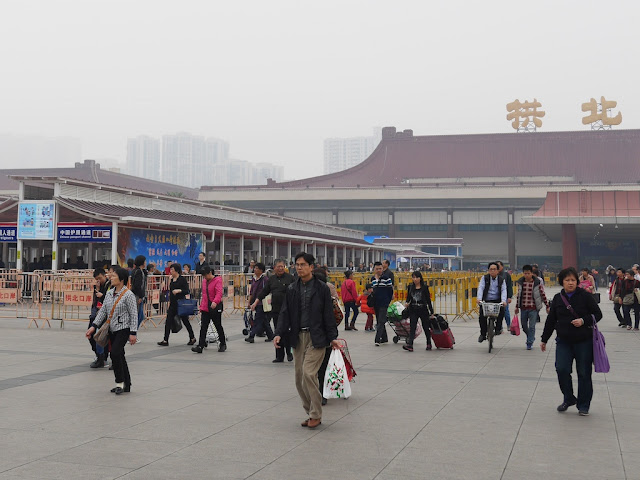 |
| People in Zhuhai, China, walking away from the border gate to Macau, China (February 2015) |
The China National Tourism Administration (CNTA) claims mainland Chinese citizens traveled "overseas" more than 100 million times last year, the most ever. This statistic is often mentioned in media reports and commentary regarding growing opportunities for countries to attract international travelers from China and their money (examples from The New York Times, Bloomberg Business, Xinhua, and Quartz). But numbers from China often come with big caveats which significantly impact their meaning. This one is no exception.
To be clear, the statistic does not cover citizens of Hong Kong or Macau, both Special Administrative Regions where a number of rules and regulations differ from the rest of China. One possible reason for omitting the two cities is if CNTA included them it would be at a loss to explain why it wasn't also including Taiwan. The People's Republic of China claims Taiwan but doesn't currently control it. Presumably CNTA doesn't have the same access to Taiwan's travel data. So clumping Taiwan, Hong Kong, and Macau together, a common thing to do in China, helps CNTA avoid highlighting a delicate issue. And there can be meaningful reasons for not including data about Hong Kong's and Macau's citizens, including many countries making it easier for them to visit by having more generous entry rules for them than for citizens of mainland China.
Less mentioned and more significant than the statistic excluding people traveling from Hong Kong and Macau is it including people traveling from mainland China to Hong Kong and Macau, where mainland Chinese need a special permit to visit. This means when a Chinese citizen living in Shenzhen travels to Hong Kong it could count as "overseas" travel despite the cities sharing a border easily crossed by foot and both undisputedly being part of the People's Republic of China. The same holds true for Macau, which borders Zhuhai.
I can't find a breakdown of the statistic for all of 2014, which was 109 million, on CNTA's website. However, in December last year CNTA provided additional details for the year's first 11 months when the number had already surpassed 100 million. According to CNTA, of those more than 100 million "outbound tours" from January through November last year:
Overseas tourist destinations of Mainland Chinese citizens are: Asia (89.5%, in which Hong Kong, Macau and Taiwan account for 70.4%), Europe (3.5%), Africa (3.0%), Americas (2.7%), Oceania (1.1%), and other regions (0.2%).Reported elsewhere, Taiwan had 2.8 million mainland Chinese tourist arrivals for all of last year. Hong Kong and Macau clearly account for a large majority of the trips. Even in the most extreme case, the final numbers for the year could not change this point.
So indicating Chinese citizens made 100 million "overseas" or "international" trips is highly misleading at best. This doesn't mean there aren't growing opportunities for countries such as the U.S. to attract international travelers from China or influence them to spend more money. I think there are. But citing the 100 million statistic isn't usually going to be a great way to make that case.
Thursday, March 26, 2015
Local Flavors: Red Bean and Black Sesame Seed Ice Cream
Posted by
Brian Glucroft
at
11:47 PM
In response to a post about milk ice cream, wallaby78 commented:
I do remember eating green bean and red been ice cream numerous times though. I enjoy both flavors, though there is a great range in quality. One recent source I saw was unexpected: McDonald's.
The above sign was at a small McDonald's outlet inside Chongqing's Niujiaotuo metro station. Unlike some other cities, eating food doesn't appear to be forbidden inside Chongqing's stations. This McDonald's is conveniently located in the path of passengers changing between two metro lines which intersect at Niujiaotuo.
Since red bean is commonly used in deserts or pastries in China, the ice cream represents another way McDonald's has localized its menu. Not only did I enjoy it far more than McDonald's Year of Fortune and Year of Luck Burgers, I ordered it on a number of occasions. It was a great way to follow up one of Chongqing's famous spicy & numbing meals, and for 5 RMB (about U.S. $0.80) it's a reasonable deal. Although the ice cream has a distinct red bean flavor, I wasn't able to detect a noticeable flavor in the cone. A McDonald's employee explained that was because there was no added flavor, just food dye to make it green.
The red bean ice cream was a temporary offering which recently ended while I was in Zhongshan. Fortunately, it was replaced with another localized ice cream flavor I enjoy: black sesame seed.
Like red bean, black sesame seed can be found in a number of desserts and pastries. And McDonald's wasn't the first place I have had black sesame seed ice cream. One of my favorites was at Very Thai Noodles in Taipei last year.
They named it the "black volcano". My recollection is that it tasted better than the McDonald's version but had a higher price. Of all the new flavors of ice cream I have tried in Asia which are not common in the U.S., black sesame seed is probably my favorite. So I heartily recommend trying a black volcano.
There are other flavors of ice cream more common in Asia than in the U.S. Someday I will write an ode or a post about the fruit which is another favorite flavor of mine — durian.
Beats the green/red bean ice cream, but not by much. Haikou has a Baskin Robbins and I loved it at first but last time the pralines and cream was so badly freezer burned that I won't be back any time soon.A Baskin-Robbins previously opened near where I once lived in Shanghai. I never noticed many customers anytime I walked by, and it eventually closed. I assume I have tried their ice cream at their other, presumably more successful, stores in China, but I don't have any specific memories.
I do remember eating green bean and red been ice cream numerous times though. I enjoy both flavors, though there is a great range in quality. One recent source I saw was unexpected: McDonald's.
The above sign was at a small McDonald's outlet inside Chongqing's Niujiaotuo metro station. Unlike some other cities, eating food doesn't appear to be forbidden inside Chongqing's stations. This McDonald's is conveniently located in the path of passengers changing between two metro lines which intersect at Niujiaotuo.
Since red bean is commonly used in deserts or pastries in China, the ice cream represents another way McDonald's has localized its menu. Not only did I enjoy it far more than McDonald's Year of Fortune and Year of Luck Burgers, I ordered it on a number of occasions. It was a great way to follow up one of Chongqing's famous spicy & numbing meals, and for 5 RMB (about U.S. $0.80) it's a reasonable deal. Although the ice cream has a distinct red bean flavor, I wasn't able to detect a noticeable flavor in the cone. A McDonald's employee explained that was because there was no added flavor, just food dye to make it green.
The red bean ice cream was a temporary offering which recently ended while I was in Zhongshan. Fortunately, it was replaced with another localized ice cream flavor I enjoy: black sesame seed.
Like red bean, black sesame seed can be found in a number of desserts and pastries. And McDonald's wasn't the first place I have had black sesame seed ice cream. One of my favorites was at Very Thai Noodles in Taipei last year.
They named it the "black volcano". My recollection is that it tasted better than the McDonald's version but had a higher price. Of all the new flavors of ice cream I have tried in Asia which are not common in the U.S., black sesame seed is probably my favorite. So I heartily recommend trying a black volcano.
There are other flavors of ice cream more common in Asia than in the U.S. Someday I will write an ode or a post about the fruit which is another favorite flavor of mine — durian.
Tuesday, March 24, 2015
Ice Cream With a Natural Flavor: Milk Ice Cream
Posted by
Brian Glucroft
at
11:51 PM
In response to the post about Cold Stone Creamery imitator Ice Stone Creamery selling ice cream in Zhongshan, China, "Potomaker" commented:
I have more to say in response to the second part of Potomaker's comment, especially since it calls to mind some fond memories of an ice cream flavor that is likely unknown to many yet couldn't be more simple.
In the U.S., ice cream I have seen for sale includes at least one flavorful ingredient, such as vanilla or chocolate, in addition to the usual standard ingredients of sugar and milk/creme. But what if someone made ice cream without any of the familiar additional flavors? And if this "flavorless" ice cream was sold at an ice cream store what should it be named? Since the flavors of this ice cream are simply milk/creme and sugar, "milk ice cream" would be a an option. It acknowledges the established use of "ice cream" as a more general term and the expectation additional words will specify the ice cream's flavor. And from a marketing perspective, "milk ice cream" may be more appealing than other options such as "plain ice cream". I am not trying to making a conclusive case it is the best option but just that it is reasonable.
And I have had ice cream named "milk ice cream" (or the equivalent in Chinese) several times in Taiwan and mainland China. Years ago when I first I heard of milk ice cream, I assumed the person introducing it to me was confused or meant vanilla ice cream. But I soon discovered that, yet again, what can seem obvious isn't necessarily so obvious. And before I knew it, I was enjoying milk ice cream.
Sometimes ice cream with this name may include at least a bit of vanilla flavoring. Nonetheless, ice cream described as having the flavor "milk" is definitely out there. And for those who are now doubting my sanity, Flying Cow Ranch in Miaoli County, Taiwan, offers one clear and definitive case of the existence of "pure" milk ice cream.
On a Yahoo Taiwan ecommerce site, Flying Cow Ranch's store sells three flavors of ice cream, as seen above, labeled in Chinese as "chocolate", "milk", and "vanilla". The listed ingredients for the milk ice cream are "raw milk, fresh cream, sugar, and milk powder". Although I wouldn't say it was my own personal favorite, I wouldn't question anyone else who declared it as theirs. And without hesitation I would recommend giving it a try if you have the chance. Like Potomaker's colleague, you might find milk to be your new favorite flavor of ice cream.
More evidence of a very immature market and uninformed consumers. I recall asking a colleague what her favorite flavor of ice cream was. Her response: milk.Before replying to the first part of Potomaker's comment, I would want to clarify what counts as a "mature market" and an "informed customer" in this case. I would also want to know why customers in Zhongshan are choosing Ice Stone and more about what the store offers them, including the overall experience. For now, I'll just say that Ice Stone's similarities to Cold Stone and my own negative impressions of their mint chip ice cream doesn't mean its customers aren't making considered decisions based on relevant information.
I have more to say in response to the second part of Potomaker's comment, especially since it calls to mind some fond memories of an ice cream flavor that is likely unknown to many yet couldn't be more simple.
In the U.S., ice cream I have seen for sale includes at least one flavorful ingredient, such as vanilla or chocolate, in addition to the usual standard ingredients of sugar and milk/creme. But what if someone made ice cream without any of the familiar additional flavors? And if this "flavorless" ice cream was sold at an ice cream store what should it be named? Since the flavors of this ice cream are simply milk/creme and sugar, "milk ice cream" would be a an option. It acknowledges the established use of "ice cream" as a more general term and the expectation additional words will specify the ice cream's flavor. And from a marketing perspective, "milk ice cream" may be more appealing than other options such as "plain ice cream". I am not trying to making a conclusive case it is the best option but just that it is reasonable.
And I have had ice cream named "milk ice cream" (or the equivalent in Chinese) several times in Taiwan and mainland China. Years ago when I first I heard of milk ice cream, I assumed the person introducing it to me was confused or meant vanilla ice cream. But I soon discovered that, yet again, what can seem obvious isn't necessarily so obvious. And before I knew it, I was enjoying milk ice cream.
Sometimes ice cream with this name may include at least a bit of vanilla flavoring. Nonetheless, ice cream described as having the flavor "milk" is definitely out there. And for those who are now doubting my sanity, Flying Cow Ranch in Miaoli County, Taiwan, offers one clear and definitive case of the existence of "pure" milk ice cream.
On a Yahoo Taiwan ecommerce site, Flying Cow Ranch's store sells three flavors of ice cream, as seen above, labeled in Chinese as "chocolate", "milk", and "vanilla". The listed ingredients for the milk ice cream are "raw milk, fresh cream, sugar, and milk powder". Although I wouldn't say it was my own personal favorite, I wouldn't question anyone else who declared it as theirs. And without hesitation I would recommend giving it a try if you have the chance. Like Potomaker's colleague, you might find milk to be your new favorite flavor of ice cream.
Tuesday, October 28, 2014
Taipei Scenes: Temples, Streets, and Drinks
Posted by
Brian Glucroft
at
7:24 PM
Although more about Taiwan will appear, since I now find myself on the much larger land mass across the Taiwan Strait, the focus here will shift. But first, I want to share a few photos which especially resonate with me and show a little more of Taipei's spirit.
 |
| At the Songshan Cultural and Creative Park |
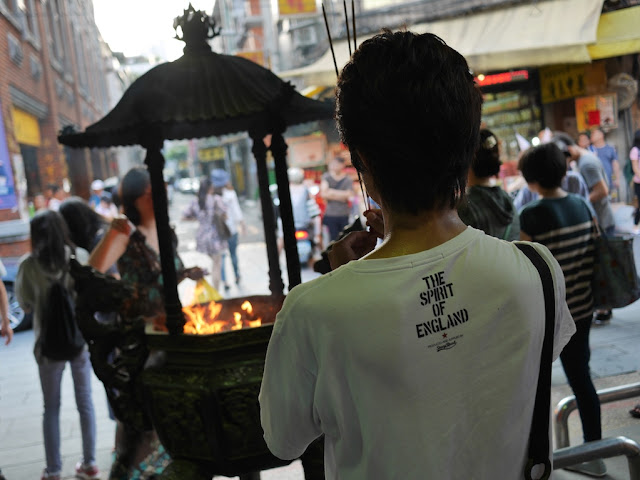 |
| Praying at the Xiahai City God Temple |
 |
| Inside the Yonglian Temple |
 |
| Looking out at the Luzhou Temple Commercial District from Yonglian Temple |
 |
| Nanhai Road at 5pm |
 |
| Xinyi Road at 5am |
 |
| One of many places for a soy milk fix |
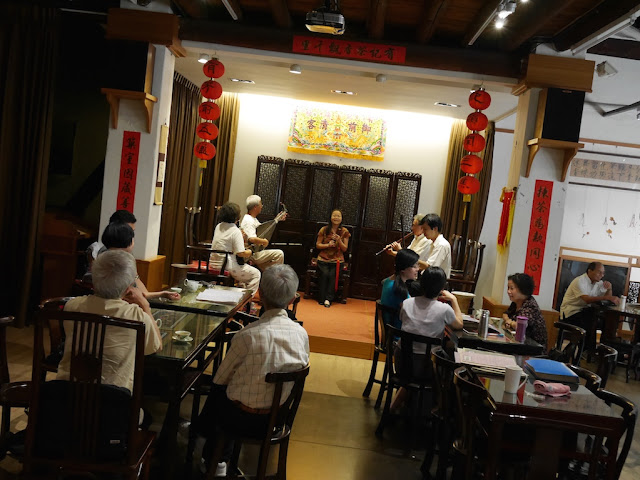 |
| Free tea and traditional music |
 |
| Xinzhuang Night Market on Xinzhuang Temple Street |
 |
| One of Taipei's many alleys |
Monday, October 27, 2014
Sunday, October 26, 2014
The Great Acceleration at the Taipei Fine Arts Museum
Posted by
Brian Glucroft
at
11:31 AM
Two months ago I entered the Taipei Fine Arts Museum and paused for a few moments as I looked at the sign listing the current exhibitions:
Needless to say, I was both surprised and disappointed to learn that the vast majority of the museum was closed in order to install a new exhibition. My visit proved to be rather brief.
Fortunately, I recently was able to return and see the new exhibition "The Great Acceleration". Not only did my visit last much longer, but I needed a second day to make a first pass through everything. As described in Art Agenda:
See the above links for more on the exhibition.
If you are in Taipei before the exhibition ends on January 4, 2015, I highly recommend spending at least an afternoon there. Below I will share photos of just a few of the installations along with excerpts of descriptions provided by the museum. The photos are not intended to be fully representative of the pieces and don't show any of the art videos. But they do provide a hint of the incredible diversity of artistic expression on display.
*Correction: an earlier version of this post mistakenly referred to the Taipei Fine Arts Museum as the Taipei Museum for the Fine Arts.
Needless to say, I was both surprised and disappointed to learn that the vast majority of the museum was closed in order to install a new exhibition. My visit proved to be rather brief.
Fortunately, I recently was able to return and see the new exhibition "The Great Acceleration". Not only did my visit last much longer, but I needed a second day to make a first pass through everything. As described in Art Agenda:
“The Great Acceleration: Art in the Anthropocene,” curated by Nicolas Bourriaud, casts human subjects as both increasingly ghostly, stressing limitations and finitudes, as well more aligned with the organic, strange, and sensory. In other words: both more dead and more alive. These qualities have been thrown into relief by the ascendance of the machinic technologies and algorithmic logics that have come to condition much of our activity and attention. Expanding on these issues, the biennial, held solely at the Taipei Fine Arts Museum, features 52 artists and collectives, finely installed. As one might expect from Bourriaud, known for coining terms and corralling practices such as “relational aesthetics,” “postproduction,” and “altermodernism,” artistic approaches, rather than particular geographies, histories, or politics, connected the works in the exhibition.And as described by exhibition curator Nicolas Bourriaud:
Human activity has been transforming the planet for millennia. All the ecosystems now bear the mark of human presence, but the scale and speed of change in the last 60 years, called by scientists The Great Acceleration, also led them to name anthropocene this new geological epoch — an era marked by the strong impact of human activities upon the atmospherical and geological evolution of planet earth.
Taipei Biennial 2014 uses this image in order to examine how contemporary art adresses this new contract between human beings, animals, vegetals, machines, products and objects. How does today’s art define and represent our space-time ? The exhibition will highlight the way artists focus on links, chainings, connections and mutations : how they envision planet earth as a huge network, where new states of matter and new forms of relations appear…
See the above links for more on the exhibition.
If you are in Taipei before the exhibition ends on January 4, 2015, I highly recommend spending at least an afternoon there. Below I will share photos of just a few of the installations along with excerpts of descriptions provided by the museum. The photos are not intended to be fully representative of the pieces and don't show any of the art videos. But they do provide a hint of the incredible diversity of artistic expression on display.
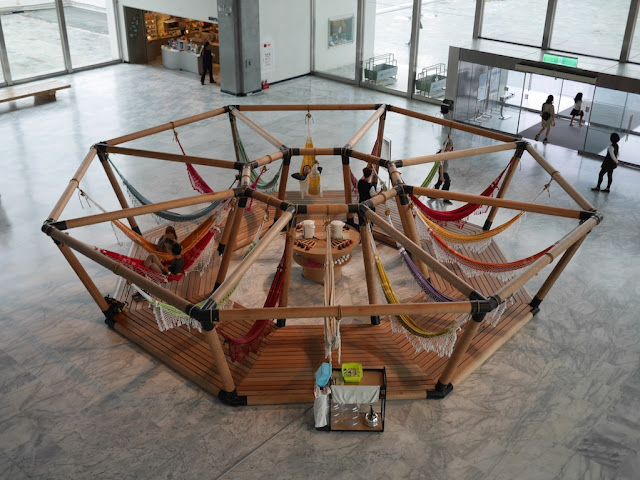 |
| Formasa Decelerator — Opavivará! (Brazil) |
Opavivará! is an art collective from Rio de Janeiro, which develops actions in public places of the city, galleries and cultural institutions, proposing inversions in the use of urban space, through the creation of relational devices that provide collective experiences.
Specially conceived for the Taipei Biennale 2014, Formosa Decelarator is also contaminated by local Brazilian traditions, rituals and tea ceremonies. . . .
The idea revolves around a sort of temple of idleness, an invitation to inactivity, a space that worships the non-productive and non-active and that stands as a counter-proposition to our accelerated, superficial and volatile times. It aims to evoke a collective ambience based on sharing and on the relationships that arise through the interaction of the public, a tool to transform the challenge of living together into a vibrant and pulsating exercise of pleasure, congregation and creative idleness.
 |
| Yucca Invest Trading Plant — Ola Pehrson (Sweden) |
Every plant is in itself a perfectly economical system, with a minimum of waste, with its own resources, something which certainly can’t be said of many companies. A yucca palm tree has been chosen as a representative of a typical plant for a young urban businessman. The plant has been exposed to six months of intensive market education, during which it has been fed with stock market rates encoded into electric currents, combined with an index-related conditioning diet of either rich or meagre rations of water and sunlight. This is an attempt to stimulate a market-adapted habitus, similar to that which years of financial transactions develop in the experienced stock brokers’ nervous system.
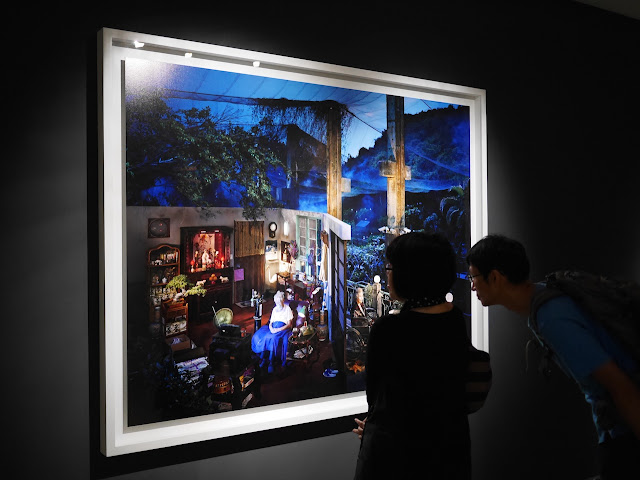 |
| Zoo — Ching-Hui Chou (Taiwan) |
Zoo is a space full of imagination and conflict. It symbolizes a time of joy (for visitors), yet it also symbolizes a time of confinement and segregation (for animals). It symbolizes the convenience and marvels of modern life (a collection of rare animals from all over the world), and it also suggests a hint of the apocalyptic salvation of Noah’s Ark (protecting species on the verge of extinction). Cages in zoos are used as an allusion to modern people’s lives in cages.
 |
| Mobile Phone and Stone Tool — Shimabuku (Japan) |
A mobile phone is one of the newest devices of humankind, and a stone tool is the oldest. Actually, they are similar in some aspects. Firstly, the size is similar. When held in a person’s hand, some of them feel very much alike. Stone tools also have “memory” just like mobile phones. You could imagine “calling” or “taking a photo” with a stone tool.
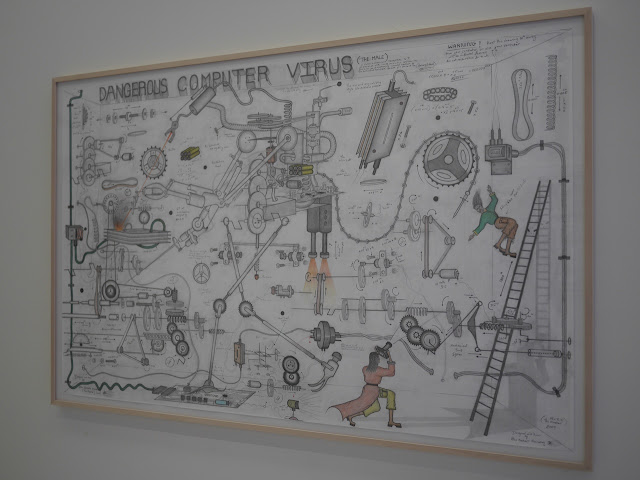 |
| Dangerous Computer Virus — Abu-Bakarr Mansaray (Sierra Leone/Netherlands) |
Mansaray’s creations particularly focus on unusual yet sophisticated drawings and machines based on his scientific background. His preparatory drawings, created by pencil, ballpoint pen or crayons, seem to be blueprints, but they can be regarded as the characteristics of his artwork, as evidenced in the works shown at the Taipei Biennial 2014. There is no doubt that the conflicting, warring circumstances of Sierra Leone play an influential role in shaping Mansaray’s creative imagination and futuristic point of view. Even though his works, to some extent, bear witness to the horrors of war, it is still evident that Mansaray attempts to express the power of creation.
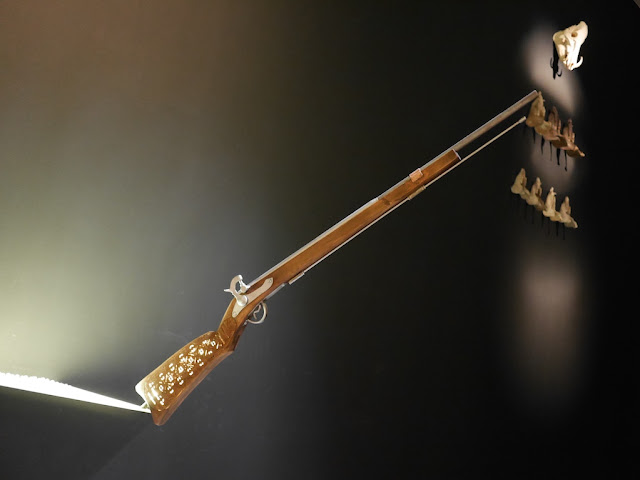 |
| Decriminalization of Taiwanese Indigenous Hunting Rifles — En-Man Chang (Taiwan) |
The term “decriminalization” refers to a situation where a previously illegal activity or action is designated legal. When legal behavior is suddenly reclassified as illegal, that is called “criminalization.” In a civilized society, how is it that the traditional hunting of indigenous peoples results in them being subject to the legal system of a different culture? In the past, hunters were the pride of the tribe, but they are now labeled criminals by the legal system because the prevailing political-economic system declines to respect cultural diversity.
 |
| Keep Soothe and Carry On — David Douard (France) |
The installation Keep Soothe and Carry On, made in 2014, is an installation that takes its starting point in its title, which Douard got from the classic English slogan “Keep Calm and Carry On.” Reflecting present-day reality, this installation is represented in the form of a marketing slogan, with the launch of several derived objects (cups, T-shirts, posters…). That is why Douard has retained the R of a trademark, serving as a powerful symbol in the installation.
He decided to use this advertisement as a tranquilizer in society. The rest of the installation serves as elements of a disordered society which the slogan addresses
 |
| Buk — Harold Ancart (Belgium) |
Buk is a plastic bucket holding a smart phone that plays “The Ultimate Very Best of Elvis” on a loop. The bucket serves as a soundbox for the smart phone as it amplifies the sound of the music released through the speaker of the phone. This anticipative sculpture witnesses a fictional lifestyle improvement for homeless people in the future. No longer subject to cold, for they will all carry electronic warming systems incorporated into their jackets, the homeless people will reunite and party around Buk rather than metallic trash cans set on fire.
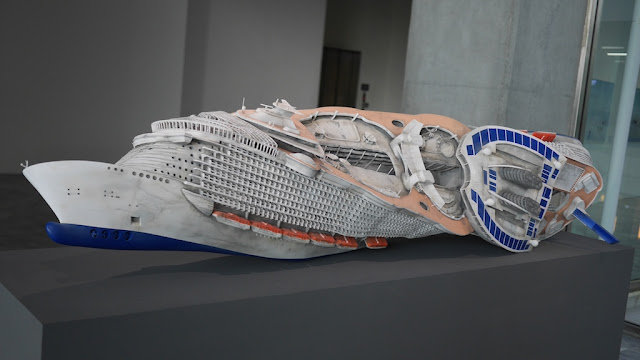 |
| The Deluge – Noah’s Ark — Hung-Chih Peng (Taiwan) |
Reflecting ferry disasters, floods and other recent ecological crises, Peng’s work The Deluge – Noah’s Ark attempts to show the impotence of human beings in the face of uncontrollable catastrophic challenges. The rapid acceleration in the Anthropocene era causes climate change, environmental pollution, and ecological crises. All the measures to control these problems seem to be in vain. Human beings are unable to return to the unspoiled living environment of the past, and have become victims of their own endeavors. This work serves as a metaphor exposing the collision between Mother Nature and the accelerated development of industrialized civilization.
*Correction: an earlier version of this post mistakenly referred to the Taipei Fine Arts Museum as the Taipei Museum for the Fine Arts.
Saturday, October 25, 2014
A Taiwanese Politician Wants People to "Lean on Me"
Posted by
Brian Glucroft
at
11:55 AM
While no other political signs in Taiwan have caught my attention as much as Lin Jinjie's (林金結) Barack Obama signs, one set comes in a clear second for their use of a familiar-to-many phrase.
Like Lin Jinjie (林金結), Ye Linchuan (葉林傳) is a member of Taiwan's Kuomintang party and he has his own page on Facebook. Unlike Lin, Ye is a council member in Taipei City and his signs do not include Barack Obama. Instead, at least some include the title of a song from the 70s by American singer-songwriter Bill Withers. Lest there be any doubt about the source of the phrase, the lyrics to the song "Lean On Me" appear in light lettering on the sign as well.
Not only did I see Ye employing this theme on several signs in Taipei, but I also saw it on the tissue boxes at a restaurant where I sometimes eat Taiwanese-style cold sesame noodles for breakfast.

As I am not familiar enough with Ye or local Taipei politics, I will refrain from commenting on the effectiveness of Ye's campaign tactics.
I will say, though, that the noodles were tasty.
Like Lin Jinjie (林金結), Ye Linchuan (葉林傳) is a member of Taiwan's Kuomintang party and he has his own page on Facebook. Unlike Lin, Ye is a council member in Taipei City and his signs do not include Barack Obama. Instead, at least some include the title of a song from the 70s by American singer-songwriter Bill Withers. Lest there be any doubt about the source of the phrase, the lyrics to the song "Lean On Me" appear in light lettering on the sign as well.
Not only did I see Ye employing this theme on several signs in Taipei, but I also saw it on the tissue boxes at a restaurant where I sometimes eat Taiwanese-style cold sesame noodles for breakfast.

As I am not familiar enough with Ye or local Taipei politics, I will refrain from commenting on the effectiveness of Ye's campaign tactics.
I will say, though, that the noodles were tasty.
Wednesday, October 22, 2014
Pumpkins and Murals
Posted by
Brian Glucroft
at
9:23 PM
During the last full day of a recent trip covering several regions of the US, I saw pumpkins at the Dallas Arboretum.
During the first full day after returning to Asia, I saw murals at Taipei's Dalongdong Baoan Temple.
On that note, I am back in Taiwan, although soon I will be headed elsewhere — a place that probably has more religious-themed murals than pumpkin-covered buildings.
During the first full day after returning to Asia, I saw murals at Taipei's Dalongdong Baoan Temple.
On that note, I am back in Taiwan, although soon I will be headed elsewhere — a place that probably has more religious-themed murals than pumpkin-covered buildings.
Thursday, September 25, 2014
A Colorful Sight in Taipei
Posted by
Brian Glucroft
at
11:40 PM
Yesterday while I walked around outside in a drizzle, I turned around and noticed something which surprised me.
The rainbow didn't strike me as remarkable except in one way—it had been a while since I had last seen a rainbow. In a post displaying the artificial rainbow I saw in Hengyang, I mentioned I couldn't remember having ever seen a genuine rainbow in China and wondered if pollution or tall buildings were significant factors. I now see that 15 years ago two scientists presented hypotheses for how pollution may have caused a decrease of rainbow sightings in Seoul, South Korea, but they don't claim to have an answer.
Whatever the case, I appreciated the rainbow.
The rainbow didn't strike me as remarkable except in one way—it had been a while since I had last seen a rainbow. In a post displaying the artificial rainbow I saw in Hengyang, I mentioned I couldn't remember having ever seen a genuine rainbow in China and wondered if pollution or tall buildings were significant factors. I now see that 15 years ago two scientists presented hypotheses for how pollution may have caused a decrease of rainbow sightings in Seoul, South Korea, but they don't claim to have an answer.
Whatever the case, I appreciated the rainbow.
Wednesday, September 24, 2014
Monday, September 22, 2014
Friday, September 19, 2014
A Taiwanese Politician and Barack Obama Want Change
Posted by
Brian Glucroft
at
7:12 PM
In the Tucheng District of New Taipei City I recently saw a small part of Taiwan's democracy in action. At one location people busily worked for an election campaign.
Lin Jinjie (林金結), a member of Taiwan's Kuomintang party, is running for the position of councilor in the New Taipei City Council.
As I walked around Tucheng, I saw some of Lin's campaign signs. Most seemed run-of-the-mill.
One sign campaign sign stood out though.
Yes, that is Lin with U.S. President Barack Obama. And the sign makes it clear both of them are full of hope for change.
During earlier primary elections some questioned Lin's use of Barack Obama's image and suggested it improperly implied Obama supported Lin or may raise copyright issues (see articles in Chinese here and here). Others commented on the prominent use of English on the sign. Despite the criticism, at least the above sign remains and an image of the sign posted on what appears to be Lin's Facebook page remains as well. Whatever its merits, that a Taiwanese political campaign believes it could be helpful to reference Obama says something about Taiwan and speaks to America's potential soft power as well.
On a related note, I have seen Barack Obama's image used for commercial purposes in mainland China. But due to differences in political systems and cultures, I doubt I will be seeing any similar Obama-themed political-campaign signs there anytime soon.
Lin Jinjie (林金結), a member of Taiwan's Kuomintang party, is running for the position of councilor in the New Taipei City Council.
As I walked around Tucheng, I saw some of Lin's campaign signs. Most seemed run-of-the-mill.
One sign campaign sign stood out though.
Yes, that is Lin with U.S. President Barack Obama. And the sign makes it clear both of them are full of hope for change.
During earlier primary elections some questioned Lin's use of Barack Obama's image and suggested it improperly implied Obama supported Lin or may raise copyright issues (see articles in Chinese here and here). Others commented on the prominent use of English on the sign. Despite the criticism, at least the above sign remains and an image of the sign posted on what appears to be Lin's Facebook page remains as well. Whatever its merits, that a Taiwanese political campaign believes it could be helpful to reference Obama says something about Taiwan and speaks to America's potential soft power as well.
On a related note, I have seen Barack Obama's image used for commercial purposes in mainland China. But due to differences in political systems and cultures, I doubt I will be seeing any similar Obama-themed political-campaign signs there anytime soon.
Subscribe to:
Posts (Atom)






